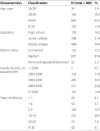1. Choi WS, Cho SA, Cho YS, Koo JW, Kim KY, Kim H-R. The relationship between the experience of an accident and post traumatic stress disorder in bus drivers. Korean J Occup Environ Med. 2011; 23(2):139–148.
2. Jo SJ, Yim HW, Kim HR, Lee KS, Park JI, Chang SM. Association of subway driver's depressive symptoms and experience of work-related problems. Epidemiol Health. 2010; 32:e2010010. DOI:
10.4178/epih/e2010010. PMID:
21191463.
3. Kim HR, Yim HW, Jo SJ, Choi B, Jeong SH, Lee KS, Park JI, Chang SM. Major depressive disorder, panic disorder, and post-traumatic stress disorder in Korean subway drivers. Int Arch Occup Environ Health. 2013; 86(4):471–477. DOI:
10.1007/s00420-012-0779-z. PMID:
22592394.
4. Woo JM, Kang TY, Lee JE. Increasing risk of mental health problems among subway drivers experiencing accidents on the track. Korean J Occup Environ Med. 2005; 17(1):36–43.
5. Yum BS, Roh JH, Ryu JC, Won JU, Kim CN, Lee JE, Kim KY. Symptoms of PTSD according to individual and work environment characteristics of Korean railroad drivers with experience of person-under-train accidents. J Psychosom Res. 2006; 61(5):691–697. DOI:
10.1016/j.jpsychores.2006.07.005. PMID:
17084148.
6. Cothereau C. Professional and medical outcomes for French train drivers after “person under train” accidents: three year follow up study. Occup Environ Med. 2004; 61(6):488–494. DOI:
10.1136/oem.2003.007922. PMID:
15150387.
7. Karlehagen S, Malt UF, Hoff H, Tibell E, Herrstromer U, Hildingson K, Leymann H. The effect of major railway accidents on the psychological health of train drivers—II. A longitudinal study of the one-year outcome after the accident. J Psychosom Res. 1993; 37(8):807–817. DOI:
10.1016/0022-3999(93)90170-K. PMID:
8301621.
8. Theorell T, Leymann H, Jodko M, Konarski K, Norbeck HE. Person under train' incidents from the subway driver's point of view—A prospective 1-year follow-up study: the design, and medical and psychiatric data. Soc Sci Med. 1994; 38(3):471–475. DOI:
10.1016/0277-9536(94)90449-9. PMID:
8153753.
9. Vatshelle Å, Moen BE. Serious on-the-track accidents experienced by train drivers: psychological reactions and long-term health effects. J Psychosom Res. 1997; 42(1):43–52. DOI:
10.1016/S0022-3999(96)00214-0. PMID:
9055212.
10. Cho MJ, Hahm BJ, Suh DW, Hong JP, Bae JN, Kim JK, Lee DW, Cho SJ. Development of a Korean Version of the Composite International Diagnostic Interview (K-CIDI). J Korean Neuropsychiatr Assoc. 2002; 41(1):123–137.
11. Bahk EJ. Subway Screen Doors to be Mandatory. The Korea Times. 2013. South Korea: The Korea Times.
12. Lee HS. Subway Engineers Vulnerable to Panic Disorder. The Korea Times. 2012. South Korea: The Korea Times.
13. WHO. Composite International Diagnostic Interview (CIDI) Version 1.0. 1990. Geneva: World Health Organization.
14. American Psychiatric Association. Diagnostic and Statistical Manual of Mental Disorders. 1994. 4. Washington (DC): American Psychiatric Press.
15. WHO. Procedures for the Development of New Language Versions of the WHO Composite International Diagnostic Interview (WHO-CIDI). 1997. Geneva: World Health Organization.
16. Cho MJ, Hahm BJ, Kim JK, Park KK, Chung EK, Suh TW, Kim SU, Cho SJ, Lee JY, Hong JP. Korean Epidemiologic Catchment Area (KECA) study for psychiatric disorders: prevalence of specific psychiatric disorders. J Korean Neuropsychiatr Assoc. 2004; 43(4):470–480.
17. Cho MJ, Chang SM, Hahm BJ, Chung IW, Bae A, Lee YM, Ahn JH, Won SH, Son J, Hong JP. Prevalence and correlates of major mental disorders among Korean adults: a 2006 National Epidemiologic Survey. J Korean Neuropsychiatr Assoc. 2009; 48(3):143–152.
18. The Epidemiological Survey of Mental Disorders in Korea. Seoul: Ministry of Health and Welfare; 2011.
19. WHO. CIDI, Core Version 2.1 Interview's Manual. 1997. Geneva: World Health Organization.
20. WHO. CIDI, Core Version 2.1 Trainer's Manual. 1997. Geneva: World Health Organization.








 PDF
PDF Citation
Citation Print
Print


 XML Download
XML Download